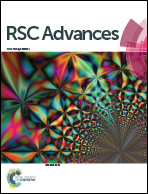Transition metal oxide@hydroxide assemblies as electrode materials for asymmetric hybrid capacitors with excellent cycling stabilities
Abstract
In this work, three-dimensional cactus-like Co3O4@Ni(OH)2 electrode materials are grown directly on Ni foam via a two-step hydrothermal method. The as-prepared products possess a specific capacitance of 464.5 C g−1 at 0.5 A g−1 and 91.67% capacitance retention after 20 000 cycles. The as-assembled device using the as-synthesized samples as positive electrodes delivers an energy density of 112.5 W h kg−1 at a power density of 1350 W h kg−1. The superior electrochemical performance of the electrode materials can be attributed to their unique structure, the synergistic effect between Co3O4 and Ni(OH)2 materials and reversible reaction kinetics. It suggests that the products are potential alternatives in future energy storage devices.



 Please wait while we load your content...
Please wait while we load your content...